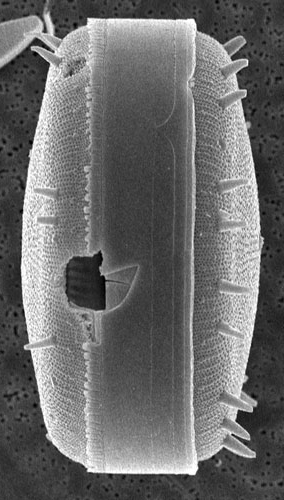|
Diatoms:
cleft confervas, or carved at the joints
Robert K. Edgar
February 2013
1
- Introduction
Generations
of novice diatomists have been introduced to diatoms with a box-model
representing these unicellular individuals as each enclosed in a glass
cell wall -- a two-part box, with a bottom and an overlapping cover,
like a petri dish or a pill box (Figures 1 & 2). They have also
usually encountered the etymology of the group's name -- a combination
of two Greek words: δια- (dia-) and τεμνειν
(temnein) = diatemnein, meaning "cut in half". Recently,
as information about diatoms has exploded on the web and as new audiences
interested in climate change, aquatic toxins, nanotechnology, biofuels
and microbial evolution meet diatoms for the first time, this morphological
précis and the name's roots continue to be commonly encountered
-- and often causally linked. From the viral entry in Wikipedia (2008-2013),
diatoms (Greek (dia) = "through"
+ temeneion (temnein) = "to cut", i.e. "cut
in half" ...characteristic feature ... cells encased within a
unique cell wall made of silica ... [consisting] of two asymmetrical
sides with a split between them, hence the group name."
[2009, my bold, Note
1],
to the sterling review in 2009 of
the life of a diatom in the journal Nature by Virginia Armbrust,
... diatoms. ... Their
name is derived from the Greek diatomos, meaning 'cut in
half', a reference to their distinctive two-part cell wall made of
silica. [again, my bold]
|

|
One is much struck by the descriptive aptness
of the name's roots to the basic cell wall structure, indeed,
to the idiosyncratic feature that captures the group's morphological
uniqueness. However, while this causal linkage of roots and
structure may infuse much current usage, it does not accurately
portray the historical genesis of the name. As applied to this
group the word diatoms is a little over 200 years old,
but our knowledge of the bipartite structure and siliceous nature
of the diatom cell wall is
not -- the name precedes the knowledge by decades. How is this
possible? Was the namer prescient? Or merely lucky? Or was something
else intended in choosing the name despite this striking goodness-of-fit?
|
<next
and previous page links below>
|
|

|
|
Figure 1
(left). A scanning electron microscope view of the cell wall
of the diatom Stephanodiscus, showing its two overlapping
saucer-shaped halves (v = valves) held together by a set of
belt-like girdle bands (gb). Image: S. M. Edgar &
E. C. Theriot, University of Texas at Austin. [Blue text indicates
the figure or text is interactive.]
|
Figure 2
(right). A brightfield light microscope view of a section of
the cell wall of a Pinnularia, showing its two overlapping
halves. The "scissors line" in each image shows where
the cut is implied by the usage cited above.
|
|


